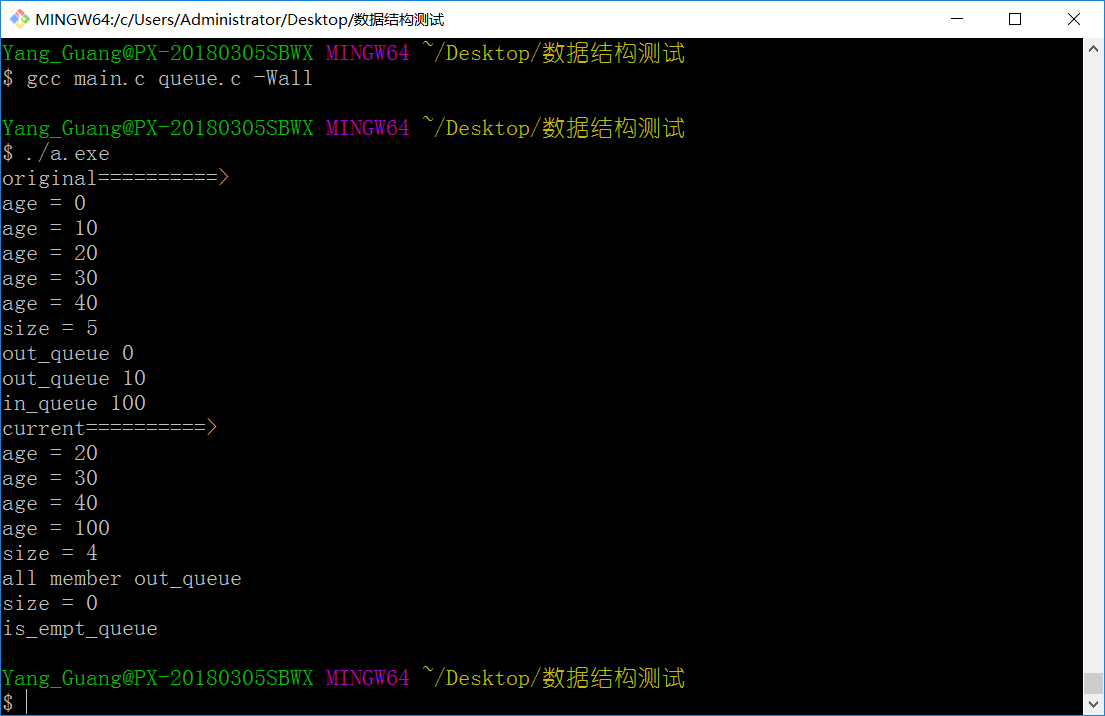Linux内核链表复用实现队列

有了前面Linux内核复用实现栈的基础,使用相同的思想实现队列,也是非常简单的。普通单链表复用实现队列,总会在出队或入队的时候有一个O(n)复杂度的操作,大多数采用增加两个变量,一个head,一个tail来将O(n)降成O(1)。但是在内核链表中,天然的双向循环链表,复用实现队列,无论出队还是入队,都是O(1)时间复杂度。
/* main.c */ #include <stdio.h> #include <stdlib.h> #include "queue.h" struct person { int age; struct list_head list; }; int main(int argc,char **argv) { int i; int num =5; struct person *p; struct person head; struct person *pos,*n; queue_creat(&head.list); p = (struct person *)malloc(sizeof(struct person )*num); for (i = 0;i < num;i++) { p->age = i*10; in_queue(&p->list,&head.list); p++; } printf("original==========>\n"); list_for_each_entry_safe(pos,n,&head.list,list) { printf("age = %d\n",pos->age); } printf("size = %d\n",get_queue_size(&head.list)); struct person test; test.age = 100; printf("out_queue %d\n",get_queue_head(pos,&head.list,list)->age); out_queue(&head.list); printf("out_queue %d\n",get_queue_head(pos,&head.list,list)->age); out_queue(&head.list); printf("in_queue %d\n",test.age); in_queue(&test.list,&head.list); printf("current==========>\n"); list_for_each_entry_safe(pos,n,&head.list,list) { printf("age = %d\n",pos->age); } printf("size = %d\n",get_queue_size(&head.list)); printf("all member out_queue\n"); list_for_each_entry_safe(pos,n,&head.list,list) { out_queue(&head.list); } printf("size = %d\n",get_queue_size(&head.list)); if (is_empt_queue(&head.list)) { printf("is_empt_queue\n"); } return 0; }
/* queue.c */ #include "queue.h" void queue_creat(struct list_head *list) { INIT_LIST_HEAD(list); } void in_queue(struct list_head *new, struct list_head *head) { list_add_tail(new,head); } void out_queue(struct list_head *head) { struct list_head *list = head->next; /* 保存链表的最后节点 */ list_del(head->next);/* 头删法 */ INIT_LIST_HEAD(list); /* 重新初始化删除的最后节点,使其指向自身 */ } int get_queue_size(struct list_head *head) { struct list_head *pos; int size = 0; if (head == NULL) { return -1; } list_for_each(pos,head) { size++; } return size; } bool is_empt_queue(struct list_head *head) { return list_empty(head); }
/* queue.h */ #ifndef _QUEUE_H_ #define _QUEUE_H_ #include <stdbool.h> #include "list.h" #define get_queue_head(pos, head, member) \ list_entry((head)->next, typeof(*pos), member) void queue_creat(struct list_head *list); void in_queue(struct list_head *new, struct list_head *head); void out_queue(struct list_head *entry); int get_queue_size(struct list_head *head); bool is_empt_queue(struct list_head *head); #endif /* _QUEUE_H_ */
运行结果:

复用Linux内核链表实现队列,时间复杂可以很简单的实现O(1),当然,其中的遍历队列长度是O(n),不过这个在之前的随笔中也说到了,根据具体的应用场景,可以在入队的时候在头结点中size+1,出队的时候在头结点中size-1,获取队列大小的函数就可以直接返回size了,是可以很轻易做到O(1)的时间复杂度的。掌握了Linux内核链表,链表,栈和队列这样的数据结构,就可以很容易的实现复用,并且可以应用在实际项目中。
欢迎加入作者的小圈子
扫描下方左边二维码加入QQ交流群,扫描下方右边二维码关注个人微信公众号并获取更多隐藏干货,QQ交流群:816747642 微信公众号:Crystal软件学堂


|
作者:Crystal软件学堂 bilibili视频教程地址:https://space.bilibili.com/5782182 本文版权归作者和博客园共有,欢迎转载,但未经作者同意必须保留此段声明,且在转载文章页面给出原文连接。 如果你觉得文章对你有所帮助,烦请点个推荐,你的支持是我更文的动力。 文中若有错误,请您务必指出,感谢给予我建议并让我提高的你。 |







【推荐】国内首个AI IDE,深度理解中文开发场景,立即下载体验Trae
【推荐】编程新体验,更懂你的AI,立即体验豆包MarsCode编程助手
【推荐】抖音旗下AI助手豆包,你的智能百科全书,全免费不限次数
【推荐】轻量又高性能的 SSH 工具 IShell:AI 加持,快人一步
· 10年+ .NET Coder 心语,封装的思维:从隐藏、稳定开始理解其本质意义
· .NET Core 中如何实现缓存的预热?
· 从 HTTP 原因短语缺失研究 HTTP/2 和 HTTP/3 的设计差异
· AI与.NET技术实操系列:向量存储与相似性搜索在 .NET 中的实现
· 基于Microsoft.Extensions.AI核心库实现RAG应用
· 10年+ .NET Coder 心语 ── 封装的思维:从隐藏、稳定开始理解其本质意义
· 地球OL攻略 —— 某应届生求职总结
· 提示词工程——AI应用必不可少的技术
· Open-Sora 2.0 重磅开源!
· 周边上新:园子的第一款马克杯温暖上架